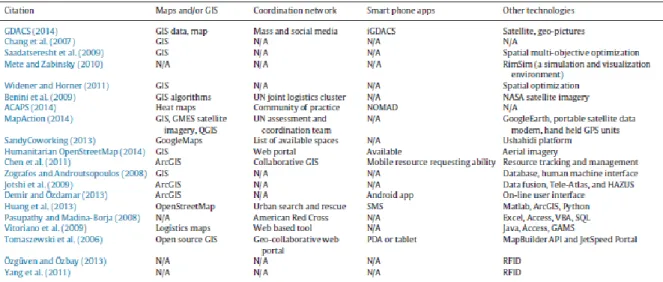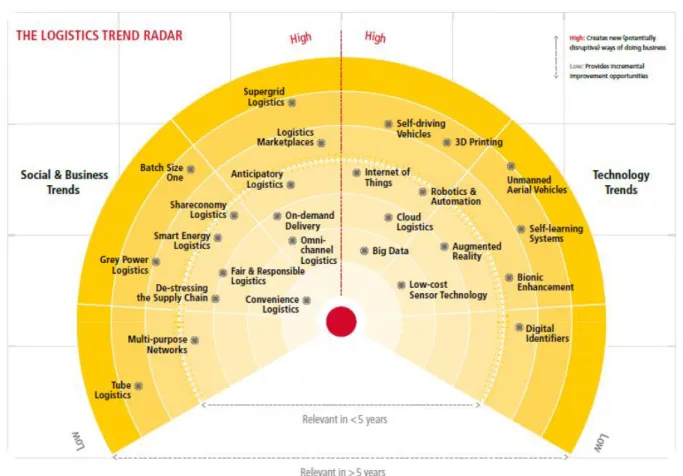Technology Related Logistic Trends and Technology Usage in
Humanitarian Logistics
Kıvanç Onan
Abstract - Humanitarian logistics (HL) is an emerging field of research since the frequency and severity of disasters and the number of people in need is continuously increasing. And because of this fact proper planning is getting more crucial. Efficiency is another important issue when it comes to disaster relief operations. Keeping these operations efficient is the key to successful implementation and therefore technology usage is essential. In this study, a framework is proposed to benefit from the technology and volunteers for HL. This study emphasizes the role of technology and people for more efficient humanitarian logistics.
Introduction
Humanitarian crisis caused by natural disasters appear to be becoming more severe and frequent (Pelling, 2003). This growing severity and frequency increases the need for better planning and according to researches it is very difficult to solve the HL problems without a proper information system (Özdamar & Ertem, 2015). Especially the improvement in mobile and web technologies, along with satellite systems, lets us to improve the infrastructures of information systems and so lets the researchers to build better frameworks (Sangiamkul & Hillegersberg, 2011).
Technological improvements not only enhance the information systems such as geographical information systems (GIS) but also change the people’s reactions during and after disasters. The role of internet in our daily lives and increasing possibilities that combines individuals to the world changes the way of individual responses during hard times. But these improvements not only affect individuals but also began to change the overall operations including the involving organizations. But still technology may have a better role in solving the problems of people in need such as; victims of disasters, refugees etc.
There are similarities and differences between commercial logistics and HL. These similarities and differences also include the technology related issues. Since HL is a non-profit type of an operation, the point of view should be different. This research conducts a discussion about technological trends in commercial logistics and technology – HL relationship. The aim is building a framework to help HL people to manage the relation between technology and HL. Briefly, this research includes a survey on the recent technology related trends in logistics and a discussion about the gap between technology and HL which is needed for offering a framework for proper technological planning and implementation in all phases of humanitarian operations.
Literature Survey
The literature on the relation between technology and humanitarian logistics is a narrow field for research. So there is a need for more detailed researches. The most related and recent papers are listed and summarized in this section.
In the book of Meier (2015), Enzo Bollettino, the executive director of the Harvard humanitarian initiative of Harvard University, defines the new era which is shaped by technology as;
“This is a world where dedicated people work closely with and in increasingly elegant and synchronous ways with the technologies and applications they have created to better the lives of those most affected by disasters.”
This was written after the Haiti 2010 earthquake when people voluntarily analyzed SMS and other social media messages to locate and help the victims of the disaster. This case highlights the importance of technology usage in humanitarian operations. He also mentions this disaster as a start of a new era, in which the humanitarian operations are totally changed by the presence of “digital humanitarians”. Another issue that should be highlighted is the importance of volunteers in HL. The spread of internet and mobile devices eventually increased the coordination and support of volunteers in HL systems. Supporting the ideas of Bollettino, Read et al. (2016) suggests that the use of SMS and other social media data is increasing. Also, he suggests that, visual technology, crisis mapping and big data technologies improve the data gathering and use of data. Shortly, it can be concluded that these advances revolutionize humanitarian operations.
Another study which highlights the importance of social media in humanitarian operations is Crumbly and Carter’s paper (2015). In their work Crumbly and Carted proposed a conceptual model which integrates social media and supply chain management. Their study mostly focuses on food charities. Agostinho (2013) also mentions the lack of resources and tools which is necessary for efficient humanitarian supply chains. The author emphasizes the importance of focusing on information to sustain efficacy. Agostinho (2013) presents the lack of investments and weakness of information systems as one of the important reasons for low efficiency. And concludes that we should utilize people and information in a better way for the ultimate goal of better aiding.
Abushaikha & Schumann-Bölsche (2016) focuses on use of mobile phones in humanitarian logistcis in their study. They also mention the limited discussion in literature on technology usage in humanitarian logistics. They used mobile technology in order to improve the performance of disaster relief operations. They offered the usage of mobile phones for better replenishments of aids. Their offer also bears the wide spread usage of mobile phones and messaging technologies and the users of these tools and applications; shortly people and information as mentioned in Agostinho’s (2013) study.
Without considering the interaction between people and technology, Özdamar & Ertem (2015) classified the technology usage in HL as;
• maps and geographical information systems, • integrated systems,
• coordination networks and
• other technologies such as remote sensing technologies (e.g. image processing and RFID etc.). Özdamar & Ertem (2015) also listed the challenges in implementation as;
• lack of real-time data,
• fragmented nature of humanitarian organizations,
• lack of commonly accepted interoperability standards among different humanitarian organizations, and
• not realizing the importance to balance good bookkeeping practices and to act fast in emergency relief operations.
Usage of the technologies in the first list above is essentially important to overcome most of these challenges mentioned in the second list. Especially integration and coordination can better be sustained by adopting the proper technology.
Table 1: The summary of the use of information systems in HL (Özdamar & Ertem, 2015)
The above table from the research of Özdamar & Ertem (2015) summarizes the literature on the use of technology in HL (Table 1). It can also be seen from this table that, information technologies (IT) are used in almost all the disaster related studies, but mostly the usage is limited to geographical information systems and in most of the cases, mobile applications are not used. Also, from the same table, it can be derived that there is a lack of technology usage in terms of coordination in some of the cases. These two findings of the authors express the need of technology usage especially in terms of coordination. Next, the following figure is about the upcoming trends in logistics (Figure1; DHL, 2016). According to the figure of DHL, one of the greatest companies of logistics sector, the technology trends with high relevance to logistics are;
• big data, • cloud logistics, • internet of things, • robotics and automation, • self-driving machines and • 3D printing (Figure 1).
DHL (2016) expects the first upcoming trend to shape the sector is big data followed by cloud logistics etc. These trends along with the technologies listed before, should be considered by the researchers in the field of HL.
• Hence these, technology related, trends in logistics, according to Özdamar and Ertem (2015) commercial solution does not satisfy HL and there is a need for methods that can deal with large scale disasters.
Figure 1: The Logistics Trend Radar (DHL, 2016) Proposed Framework
The key points summarized from the literature survey part are as follows;
• technology usage is very crucial in terms of overcoming the challenges in HL
• people’s relation with social media and mobile devices played a critical role in recent disasters • data is very important for HL; both in terms of collection and analysis
• fast response is very crucial in the times of life and death situations • probably the best adopted technology in HL is GIS
• real-time streaming of data and its immediate usage is vital
• hence the organizations are fragmented, coordination and integration is a big problem in HL • commercial solutions one by one utilize technological advancements such as cloud computing
and big data etc. but these methods do not satisfy HL needs because of its different nature • probably one of the least used technologies is mobile applications in HL except the ones with
messaging features
These points listed above highlights the importance of mobile technology and collection/analysis of data along with volunteers in terms of humanitarian operations. So, it is essential to develop a guide for these parties, in order to better benefit from technology and at the same time increase the efficiency of humanitarian logistics.
Table 2: Proposed framework to benefit from technology in data collection and analysis phases of HL (BD: before disaster, DD: during disaster, AD: after disaster)
Training Data collection Data analysis Voluntary individuals Attend trainings, distribute knowledge (BD) Use non-commercial technology (DD-AD) Support analysis of data and use results (DD-AD) Solution providers Develop trainings for individuals (BD) Develop non-commercial technology (BD) Develop and run real–time online analysis tools (DD-AD) Social media Announce
trainings and distribute notes (BD) Adapt to developed technologies (BD) Perform analysis and report results (DD-AD)
Other actors of HL are national and international NGOs, governmental agencies, suppliers etc. These actors should be involved in all stages of this plan in terms of regulating, coordinating, and incorporating the process. This revolution was started by individuals with the help of internet and mobile technology, now this knowledge learned from previous disasters can be used to drive all actors for the better of people in need, with the help of all kinds of technologies.
Conclusions
Reviewing the key points, it is obvious that there is a need to find a way for utilizing technological advancements in HL operations. So, the question is which technologies should be invested in terms of humanitarian logistics. It was clearly seen from the literature survey that involvement of volunteers with the help of technology revolutionized the way we look at HL. So, it can be suggested that the technologies that can increase the capabilities and effectiveness of voluntary individuals should be considered. Also, commercial solution providers in logistics sector may be encouraged to develop methods which can be used during the times of disasters. Here the governmental agencies may play an important role by providing incentives such as tax reductions. Briefly people and information matters and best way to gather information is through people and their mobile devices.
References
Abushaikha, I., & Schumann-Bölsche, D. (2016). Mobile phones: Established technologies for innovative humanitarian logistics concepts. Procedia Engineering, 159, 191-198.
Agostinho, C. F. (2013). Humanitarian Logistics: How to help even more?. IFAC Proceedings Volumes, 46(24), 206-210.
Crumbly, J., & Carter, L. (2015). Social media and humanitarian logistics: The impact of task-technology fit on new service development. Procedia Engineering, 107, 412-416.
DHL (2016) Logistics Trend Radar, retrieved from DHL website on 17th of September 2017:
http://www.dhl.com/content/dam/downloads/g0/about_us/logistics_insights/dhl_logistics_trend_radar _2016.pdf
Meier, P. (2015). Digital humanitarians: how big data is changing the face of humanitarian response. Crc Press.
Mosterman, P. J., Sanabria, D. E., Bilgin, E., Zhang, K., & Zander, J. (2014). A heterogeneous fleet of vehicles for automated humanitarian missions. Computing in Science & Engineering, 16(3), 90-95. Özdamar, L., & Ertem, M. A. (2015). Models, solutions and enabling technologies in humanitarian logistics. European Journal of Operational Research, 244(1), 55-65.
Pelling, M. (2003). Natural disaster and development in a globalizing world. Routledge.
Read, R., Taithe, B., & Mac Ginty, R. (2016). Data hubris? Humanitarian information systems and the mirage of technology. Third World Quarterly, 37(8), 1314-1331.
Sangiamkul, E., & Hillegersberg, J. (2011). Research directions in information systems for humanitarian logistics.

